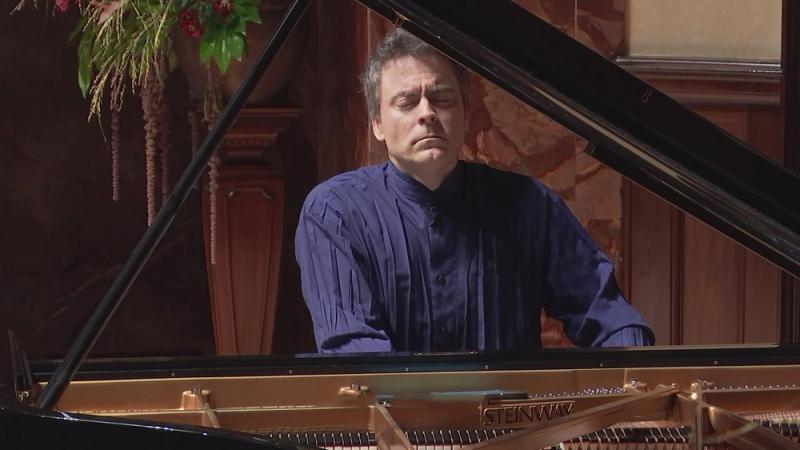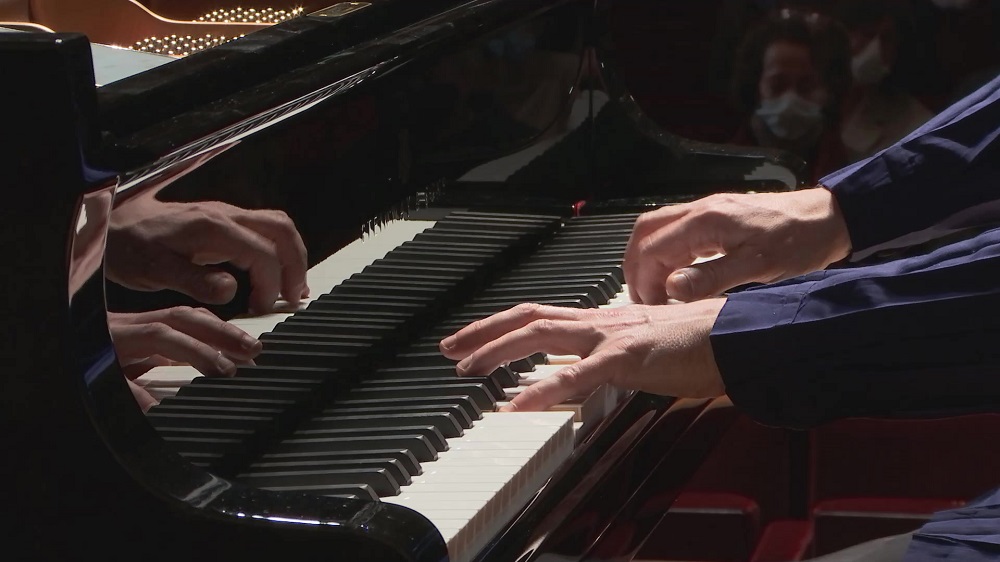Paul Lewis, Wigmore Hall review – Classical consolations | reviews, news & interviews
Paul Lewis, Wigmore Hall review – Classical consolations
Paul Lewis, Wigmore Hall review – Classical consolations
Haydn and Beethoven's Diabelli Variations, putting life in perspective

The key of C minor threw a dark shadow over music long before it became the tonality for Beethoven to express the struggle of one against many in the Fifth Symphony and the Third Piano Concerto.
His measured, patient approach drew out every note of restrained pathos from Haydn’s falling phrases without disturbing their formal contours. In the ornamentation of the central Andante, too, Lewis evoked a Baroque world of fantasy in the embroidered melodic line, picking out top notes like snowdrops. Springy articulation preserved a lightness of being even in those sequences of the finale where Haydn most nearly approaches the pathos of C minor Mozart.
Rather than the conventional sunny-side-up major-key ending, Haydn closes out the sonata with another simple dying fall. Lewis made from it a marvellously apt prelude to the work that raises a “life must go on” philosophy to sublime heights, the Diabelli Variations of Beethoven. He got straight to work with Diabelli’s funny little waltz, and ignored the invitation of the initial march to raise the curtain with swagger and brilliance in favour of a sturdy momentum, playing a long game through the twists of the 33-variation sequence. Thus the more arcane harmonies of Variation 3 ushered in the poky inquisitions of the fourth, articulated like an over-attentive waiter with Beethoven’s impatient response. The cosmic humour of the trills in Variation 6 turned naturally into the vaulting leaps of the seventh, answered in turn by the right-hand consoling chorale voices of No 8.  All of human life was here, in C major – absurd, profound, resigned and furious. Pausing before the Allegretto of No 10 introduced a welcome structural caesura as well as a measure of reflection before the cycle’s first full point of stillness in the space-becoming-silence of No 14, Grave e maestoso as marked but sprung and feather-blown by the sure and serious touch of Lewis’s Haydn. As in the sonata’s finale, a few scrambled semiquavers hardly obscured the clarity of his vision for the piece. The composition of the Diabellis bookended Beethoven’s four-year labour over the Missa solemnis, and both works collapse past, present and future into a single span. The meditation of Variation 20 brings some of his most speculative harmonies, and Lewis accordingly treated them like late Liszt, adrift on some mystic gondola – before No 21 broke the spell as if an eavesdropping army of servants, rooted to the spot, had been barked to attention and promptly dropped all the dishes.
All of human life was here, in C major – absurd, profound, resigned and furious. Pausing before the Allegretto of No 10 introduced a welcome structural caesura as well as a measure of reflection before the cycle’s first full point of stillness in the space-becoming-silence of No 14, Grave e maestoso as marked but sprung and feather-blown by the sure and serious touch of Lewis’s Haydn. As in the sonata’s finale, a few scrambled semiquavers hardly obscured the clarity of his vision for the piece. The composition of the Diabellis bookended Beethoven’s four-year labour over the Missa solemnis, and both works collapse past, present and future into a single span. The meditation of Variation 20 brings some of his most speculative harmonies, and Lewis accordingly treated them like late Liszt, adrift on some mystic gondola – before No 21 broke the spell as if an eavesdropping army of servants, rooted to the spot, had been barked to attention and promptly dropped all the dishes.
In this metaphysic play – the Diabellis as a story of performance – Lewis brought first Mozart (Leporello, in Variation 22) and then Bach (the Goldbergs’ “Black Pearl” refracted through No 31) on to the stage without rolling out the red carpet. Even the extraordinary bridge from climactic fugue to concluding minuet was handled with love but also the sense of a beating pulse: life really does go on. The audience, readmitted to the hall for the first time in some weeks, applauded Lewis as if in grateful recognition.
rating
Explore topics
Share this article
The future of Arts Journalism
You can stop theartsdesk.com closing!
We urgently need financing to survive. Our fundraising drive has thus far raised £49,000 but we need to reach £100,000 or we will be forced to close. Please contribute here: https://gofund.me/c3f6033d
And if you can forward this information to anyone who might assist, we’d be grateful.

Subscribe to theartsdesk.com
Thank you for continuing to read our work on theartsdesk.com. For unlimited access to every article in its entirety, including our archive of more than 15,000 pieces, we're asking for £5 per month or £40 per year. We feel it's a very good deal, and hope you do too.
To take a subscription now simply click here.
And if you're looking for that extra gift for a friend or family member, why not treat them to a theartsdesk.com gift subscription?
more Classical music
 Kempf, Brno Philharmonic, Davies, Bridgewater Hall, Manchester review - European tradition meets American jazz
Bouncing Czechs enjoy their Gershwin and Brubeck alongside Janáček and Dvořák
Kempf, Brno Philharmonic, Davies, Bridgewater Hall, Manchester review - European tradition meets American jazz
Bouncing Czechs enjoy their Gershwin and Brubeck alongside Janáček and Dvořák
 Solomon, OAE, Butt, QEH review - daft Biblical whitewashing with great choruses
Even a top soprano and mezzo can’t make this Handel paean wholly convincing
Solomon, OAE, Butt, QEH review - daft Biblical whitewashing with great choruses
Even a top soprano and mezzo can’t make this Handel paean wholly convincing
 Two-Piano Gala, Kings Place review - shining constellations
London Piano Festival curators and illustrious friends entertain and enlighten
Two-Piano Gala, Kings Place review - shining constellations
London Piano Festival curators and illustrious friends entertain and enlighten
 Echo Vocal Ensemble, Latto, Union Chapel review - eclectic choral programme garlanded with dance
Beautiful singing at the heart of an imaginative and stylistically varied concert
Echo Vocal Ensemble, Latto, Union Chapel review - eclectic choral programme garlanded with dance
Beautiful singing at the heart of an imaginative and stylistically varied concert
 Scott, Irish Baroque Orchestra, Whelan, RIAM, Dublin review - towards a Mozart masterpiece
Characteristic joy and enlightenment from this team, but a valveless horn brings problems
Scott, Irish Baroque Orchestra, Whelan, RIAM, Dublin review - towards a Mozart masterpiece
Characteristic joy and enlightenment from this team, but a valveless horn brings problems
 Classical CDs: Voice flutes, flugelhorns and froth
Baroque sonatas, English orchestral music and an emotionally-charged vocal recital
Classical CDs: Voice flutes, flugelhorns and froth
Baroque sonatas, English orchestral music and an emotionally-charged vocal recital
 Kanneh-Mason, Britten Sinfonia, Shave, Milton Court - a grin and a big beaming smile
A pair of striking contemporary pieces alongside two old favourites
Kanneh-Mason, Britten Sinfonia, Shave, Milton Court - a grin and a big beaming smile
A pair of striking contemporary pieces alongside two old favourites
 theartsdesk at the New Ross Piano Festival - Finghin Collins’ musical rainbow
From revelatory Bach played with astounding maturity by a 22 year old to four-hand jazz
theartsdesk at the New Ross Piano Festival - Finghin Collins’ musical rainbow
From revelatory Bach played with astounding maturity by a 22 year old to four-hand jazz
 First Person: Manchester Camerata's Head of Artistic Planning Clara Marshall Cawley on questioning the status quo
Five days of free events with all sorts of audiences around Manchester starts tomorrow
First Person: Manchester Camerata's Head of Artistic Planning Clara Marshall Cawley on questioning the status quo
Five days of free events with all sorts of audiences around Manchester starts tomorrow
 Goldscheider, Brother Tree Sound, Kings Place review - music of hope from a young composer
Unusual combination of horn, strings and electronics makes for some intriguing listening
Goldscheider, Brother Tree Sound, Kings Place review - music of hope from a young composer
Unusual combination of horn, strings and electronics makes for some intriguing listening

Add comment